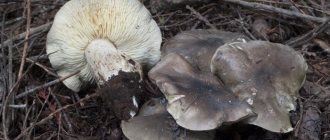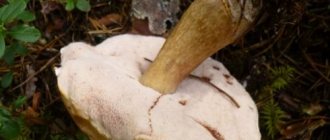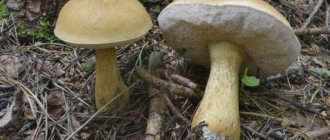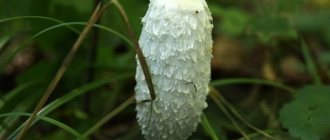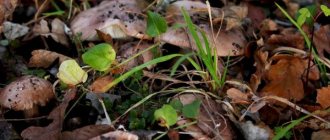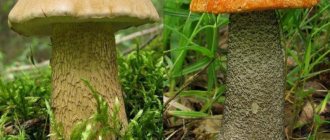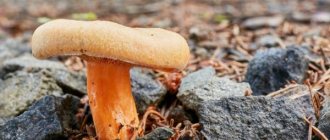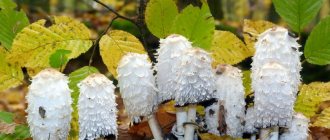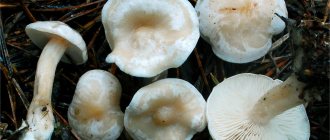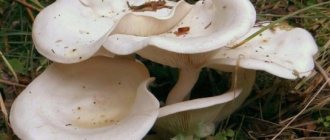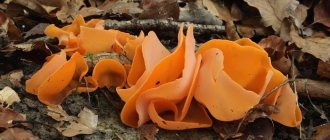Orange talker Hygrophoropsis aurantiaca is a false mushroom that is often confused with the highly prized edible chanterelle Cantharellus cibarius. The fruiting surface is covered with a multiply branched gill-like structure, which is very characteristic and lacks the cross veins of chanterelles. Some people consider orange talker to be safe to eat (but have a bitter taste), but in general mushroom pickers do not collect this species.
The French mycologist Rene Charles Joseph Ernest Maire in 1921 transferred the orange talker to the genus Hygrophoropsis, and gave the currently accepted scientific name Hygrophoropsis aurantiaca.
What do orange talkers look like?
The diameter of the mushroom cap is from 3 to 10 cm. Initially, it is convex, with folded edges. As it grows, the form becomes prostrate and depressed. In adult specimens, the cap is funnel-shaped, with thin wavy edges. Its color is orange, with a yellowish or brown tint. It is darker in the center, towards the edges the tone becomes light yellow, and with age it becomes almost white. The surface of young talkers is dry and velvety.
A mushroom with frequent, thick, descending plates with many branches. When pressed they turn brown.
The length of the cylindrical leg is 3-6 cm. The diameter is up to 1 cm. The leg narrows towards the base. Its surface is yellow-orange, like the plates of the mushroom. Often the leg bends at the base.
The flesh of the false chanterelle is red, compacted, and softer towards the edges. As the fungus grows, it becomes cotton-like, acquiring a pale yellowish tint.
Where do they grow?
It is clear that before you cook talker mushrooms, you need to buy or collect them. If you are a fan of quiet mushroom hunting, then we will tell you where these representatives of the numerous mushroom world grow.
Let us immediately note that the talker is a mushroom very beloved by experienced mushroom pickers. While some species have to be literally hunted, talkers grow in entire families in large clearings. If you attack such a family, you can easily pick up a whole basket of mushrooms in one sitting.
Depending on the species, the type of area in which the mushroom grows will also change. For example, the smoky talker is very fond of pine and mixed forests. It can easily be found in the rotted leaves under the spruce on a sunny day. Whitish talkers most often grow near birch or spruce trees. There are a lot of them in the Urals and Siberia. In Crimea and in the temperate zone you can easily find reddish talkers. They are very fond of spruce and pine forests. A sunny day, an open clearing next to such a forest - and you have a whole supply of mushrooms for the winter “in your pocket” in a matter of minutes.
Benefits and harm to the body
Despite its mild taste, eating orange talker has a positive effect on the body:
- in the fight against infectious diseases;
- when removing toxins, thanks to the composition of enzymes;
- to improve the functioning of the gastrointestinal tract, restore the digestive process;
- while reducing cholesterol levels and the risk of blood clots.
Important! People with food sensitivities should avoid eating false chanterelle: the mushroom can cause an exacerbation of gastroenteritis.
Application in medicine
The medical importance of many types of mushrooms is difficult to overestimate.
- The talker is no exception, as it helps in the following cases:
- raises the overall tone of the body;
- helps in preventing infections;
- normalizes digestion;
- removes toxins;
- reduces blood cholesterol levels;
- reduces the likelihood of blood clots.
Traditional medicine offers a whole range of preparations based on this mushroom - extracts, ointments, decoctions. They help in healing even large wounds. These drugs are also used in the treatment of asthma and reduce urinary tract obstruction.
You might be interested in learning how to grow champignons in a greenhouse.
False doubles
The talker has no poisonous counterparts; it can only be confused with edible and conditionally edible varieties:
- The real chanterelle, with which the orange talker has common fruiting dates and places of growth. The distinctive features of the “original” are its fleshy and brittle consistency. The real chanterelle also has a less saturated color of the plates and legs.
- The false chanterelle is red, which can be recognized by its pronounced scales and darker color in the central part of the cap.
Important! Some are afraid to confuse the false chanterelle with the poisonous orange-red talker, but this is extremely difficult: the fruiting body of the latter is distinguished by an orange-red scaly surface with a brown tint, as well as a sharp, unpleasant odor.
Interesting facts about the mushroom
- The red talker (Clitocybe rivulosa) emits a pale greenish light in the dark.
- Some species of this mushroom grow in groups that form circles in forest clearings. Previously, they were called witch rings; it was believed that in such places the furies staged their dances at night.
- Talkers should not be consumed with alcohol, as this can lead to intoxication.
If, despite the above, you still decide to collect false chanterelle mushrooms, then remember that only the caps of young mushrooms are used for food.
Also, be sure to heat-treat the collected fruits, since the orange talker is a conditionally edible species.
Information sources
- Dermek A. Mushrooms. - Bratislava: Slovart Publishing House, 1989.
- Lesso T. Mushrooms. Determinant. - Moscow: AST publishing house, 2003
Collection rules
There are several main rules for collecting mushrooms. By following the recommendations, you can avoid unwanted consequences:
- You should not collect mushrooms near highways, military training grounds or chemical plants.
- Only young specimens should be collected, since adult mushrooms are capable of accumulating dangerous toxins.
- It is necessary to cut off the fruiting bodies in the middle of the stem, and then cover the mycelium with pine needles.
- Before harvesting, it is important to make sure that none of the mushrooms are wormy.
- It is not recommended to keep fruiting bodies in the refrigerator for longer than 24 hours.
- Immediately after picking, the mushrooms need to be boiled. Otherwise, at room temperature they can quickly deteriorate.
How to prepare and preserve chanterelles for medicinal purposes
But before you use chanterelles for treatment, you need to properly collect them and subject them to the necessary processing.
It is necessary to remove dirt and debris from the collected mushrooms with a dry brush. The more carefully you do this, the longer their shelf life will be. There is no need to wet fresh chanterelles. After this, you can store the chanterelles in the refrigerator for no more than 10 days.
Next you need to choose in what form to use the mushrooms - salted, dried or frozen. Freezing chanterelles will ensure the preservation of all beneficial properties.
The flesh of dried chanterelles can become rubbery, so they are usually ground into a powder that has a shelf life of about a year. In this case, the temperature when drying mushrooms should not exceed 40°C.
Accordingly, for medicinal purposes, chanterelles are eaten fresh or in powder form. The powder is added to prepared dishes. Boiled and fried mushrooms will have much less nutrients.
How to cook orange talkers
In the culinary field, only the caps of young orange talkers are used: the stems of the mushroom are unsuitable for food due to their dense structure. The caps are first cleaned of dirt, thoroughly washed and boiled for 25-30 minutes. Afterwards they can be stewed, fried, or used as an ingredient for soup.
There are also known recipes for pickling and salting orange talkers. There is no need to pre-soak the mushrooms: just clean them of debris, rinse under running water and boil in salted boiling water. Prepared fruiting bodies can be prepared according to the chosen recipe.
Symptoms of poisoning
When eating waxy or whitish talker, symptoms of poisoning appear within 15–30 minutes, or less often later.
The patient complains of:
- nausea;
- stomach ache;
- labored breathing;
- heat;
- visual impairment.
Objectively, you can notice the symptoms of poisoning:
- facial redness;
- vomiting;
- increased salivation;
- intestinal upset (diarrhea);
- increased sweating;
- bradycardia;
- bronchospasm;
- decreased blood pressure;
- convulsions.
One of the important symptoms of poisoning by whitish, waxy or fly agaric is a spasm of accommodation or a narrow pupil. This is what causes visual impairment in the patient, the so-called false myopia.
There are also symptoms of damage to the nervous system, but these are not hallucinations, but confusion, the patient becomes inadequate, does not understand where he is. Often there is fear or attacks of aggression, which can suddenly give way to euphoria.
Side effects of muscarine are trembling and chills. Possibly urinary disturbances in the form of frequent urination. All these symptoms are associated with effects on smooth muscle M receptors. Often, the symptoms of poisoning can go away on their own, their severity decreases 2-3 hours after poisoning. If the amount of muscarine entering the blood is large, death is possible.
Clubfoot
If you prefer mushrooms that have a sweetish aroma, then we advise you to pay attention to this “version” of talkers. The clubfoot is the most recognizable and commonly collected variety of edible talker mushroom. The mace resembles the stem of a mushroom. The hat of this species is quite small, one might say miniature.
This species is very popular among chefs because the product has absolutely no taste. It can be combined with absolutely any food, you can add any spices and seasonings you like. And the pleasant sweetish smell is also not repellent.
Voronchataya
This mushroom with a cap of eight centimeters is also distinguished by a specific smell. This species smells like some kind of perfume composition. Mushroom pickers don’t particularly like to collect such talkers, because when cooking, the kitchen smells of old perfume that has passed its expiration date.
The outstretched shape of the cap distinguishes the funnel talker from its other counterparts in appearance. It is important to remember that this type of mushroom can only be consumed at a young age. An aging talker will be very tough and tasteless, and the specific aroma, which not everyone likes, will only intensify.
Edible species
As we have already said, talker is a mushroom with a specific and rather bright smell. Many mushroom pickers probably bypass it, not realizing that it is this smell that is the highlight of these forest gifts.
If you decide to collect their mushrooms and want to make something tasty out of them, then we will take a closer look at the talker mushrooms. A description of the preparation process will also be given below.
Risotto with talkers
Products
Govorushki - 1 kilogram Rice (round grain) - 1 cup Chicken broth (can be replaced with chicken cubes) - 4 cups Vegetable oil (olive) - 1 tablespoon Onion - 1 piece Garlic - 2 cloves Fresh pepper - 100 grams Fresh tomatoes - 100 grams Canned corn - 50 grams Canned green peas - 50 grams Salt, black pepper - 1/2 teaspoon Butter - 4 tablespoons Hard cheese (Parmesan) - 1/4 cup Fresh parsley - to taste
How to cook risotto with talkers
1. Clean and cook talkers. 2. Cut the pepper and tomato into 1.5 centimeter cubes. 3. Wash and finely chop the parsley. 4. Grate the cheese on a fine grater. 5. Heat chicken broth. 6. Peel and finely chop the garlic and onion. 7. Put 2 tablespoons of butter and govorushki into a saucepan or stewpan. 8. Fry the talkers for 5-6 minutes with constant stirring over medium heat. 9. Remove the mushrooms from the pan and add vegetable oil, onion and garlic. 10. Fry for 2 minutes, the garlic should become soft. 11. Add rice to the pan and fry it along with the onion and garlic, stirring constantly, for another 5 minutes. 12. Place peas and corn in rice. 13. Add broth gradually, half a glass at a time, stir and wait until it is absorbed into the rice, then add the next half glass. 14. If the broth is over, and the rice is still crunchy in your teeth, add another half a glass of water and, stirring, wait until the rice is completely cooked. 15. After the rice with talkers is ready, turn off the stove and add mushrooms, cheese, butter and parsley to it. 16. Stir and taste. If there is not enough salt, add salt. 17. Serve risotto with talkers in deep bowls.
Edible and inedible talker mushrooms and their description (+39 photos)
Talker mushrooms are one of the most commonly found mushrooms in our forests. They are in great demand among mushroom pickers, as they have high taste and a minimum of poisonous counterparts. After reading the photo and description, it is easy to recognize talker mushrooms - these are cap-shaped funnel-shaped fruits of small size, growing in groups. They most often grow in deciduous forests. Basically, only their cap is eaten.
Characteristic features of talkers
Govorushki belong to the type of cap mushrooms and the family of row mushrooms. They also have some differences between themselves, which need to be studied in order to distinguish edible varieties from inedible ones. There are also poisonous species in the genus, so collecting this species is recommended only for experienced mushroom pickers.
Appearance and photo
All representatives have fruiting bodies of medium or small size. The average diameter of the cap is 3-7 cm. The cap is mostly light in color, sometimes grayish, and has a small depression in the center - it is funnel-shaped.
The cap is smooth and dry to the touch. The mushroom stem is thin and tall. On the back of the cap there are thin, white plates that extend to the upper part of the stem. The spore powder of the fungus is light, sometimes creamy.
Place of distribution
You can meet talkers most often in deciduous forests. This is where they form mycorrhizae with trees. Organisms grow in groups, often called a witch's circle. This phenomenon is accompanied by the growth of a large number of mushrooms in a circle, with an empty space in the center.
In addition to forests, this species can also be found in grassy areas, for example, in meadows or parks. In Russia, mushrooms are common in temperate climates, and can also be found in the forests of Siberia and the Primorsky Territory.
Collection rules
Experienced mushroom pickers recommend collecting talkers from mid-August to October. Their yield peaks in mid-September. Many varieties of talkers grow in groups, which makes collection much easier.
The place where talkers are collected depends on the characteristics of the variety, however, most of them grow in forests near trees, where a large number of fallen leaves or moss predominate.
Edible talkers with photos
In order not to confuse edible varieties with poisonous ones, you need to be able to distinguish them by external signs. Distinctive features and descriptions of edible varieties with photos are presented below.
The talker is bent
This mushroom grows both individually and in large groups-circles, which are localized mainly on the edges of forests, near roads and in thickets of bushes. The mushroom has a large, smooth cap, the diameter of which often exceeds 12 cm. It is dirty yellow in color. The plates are white, gradually acquiring a pinkish tint.
The leg is dense in consistency and tall, about 15-20 cm. The color is the same as the cap. The pulp is dry. In young mushrooms it is white, but over time it becomes brown and acquires an unpleasant odor, so only young fruiting bodies need to be collected. Peak yield occurs at the end of summer and lasts until October. For cooking, only young mushrooms are used, which are marinated or boiled.
Gray
The cap of this variety is smaller in size than the previous one and has an average diameter of 8-15 cm. The consistency is thick and fleshy, and the color can be in different shades of gray. The plates are also characterized by a gray tint. The leg is wide, dense, low, matching the color of the cap.
The pulp exudes an aroma reminiscent of soap. Most often, the mushroom is found in large groups in mixed and coniferous forests. You can find it in the forest from late summer to November. Before salting or pickling the gray talker, it must be thermally treated - boiled for 30-40 minutes in boiling water.
Goblet
A special feature of this variety is the goblet-shaped cap, about 7-8 cm in diameter. It has inward-turned edges, a glossy surface and is colored brown or ash-gray. The plates are few and have a brown color. The pulp is thin and watery in consistency.
The leg is high, about 10 cm, the part near the ground is fluffy and widened. The goblet variety can be found in coniferous, mixed, and deciduous forests, where the forest floor is rich in organic matter. Peak fertility occurs in August and lasts until September inclusive. The mushroom is consumed boiled or salted.
Orange
Orange talkers often grow in small groups or singly. They bear fruit from late summer to October. They are found in the damp part of coniferous or mixed forests, the litter of which contains a large amount of moss and fallen rotten leaves.
The mushroom is small in size, yellow-orange in color, and gradually becomes faded. The plates smoothly move onto the leg, and when pressed, change color to a darker one. The leg is low, on average 5 cm, round in shape, becoming thinner closer to the ground. The pulp is yellowish and odorless. Only the cap, which is fried or boiled, is eaten.
Voronchataya
The name of the variety speaks for itself, since the shape of the cap very much resembles a funnel, it is about 8 cm in diameter. The surface is dry, the edges are wavy, and has a dirty yellow color. The plates smoothly transition to the leg. The pulp has a powdery odor. The leg is high, 8 cm long, thin, solid.
Funnel talkers are among the most common varieties of this species, and they can be found on fallen leaves near forest paths, in bushes in small groups or individually. Before cooking it is thermally treated. This species can be dried and also eaten together with other mushrooms.
Anise
Anise talkers are a less common variety of this species. The main feature of this variety is the variable shape of the cap. So, initially the mushroom has a cap curved inward, which straightens over time. The color is predominantly green, with a gray tint. The leg is low, rounded.
